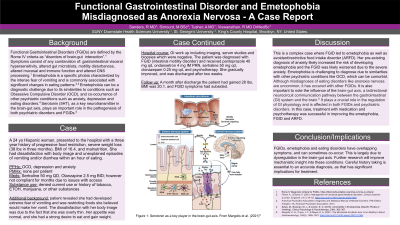Obesity, Nutrition, and Eating Disorders
Session: Poster Session
(116) Functional Gastrointestinal Disorder and Emetophobia Misdiagnosed as Anorexia Nervosa: A Case Report

Trainee Involvement: Yes
- RS
Renata Sanders, MD
CL Psychiatry Fellow
SUNY Downstate Health Sciences University
Cedarhurst, New York, United States - MS
Melanie A. Simourd, BSc
Medical Student
St. George's University
Brooklyn, New York, United States - AT
Alan Tusher, MD, PhD, DFAPA
Director, Adult CL psychiatry
Kings County Hospital Center
Brooklyn, NY, New York, United States .jpg)
Ramaswamy Viswanathan, MD, DrMedSc, FACLP
Professor and Interim Chair, Department of Psychiatry and Behavioral Sciences
State University of New York Downstate Health Sciences University
Brooklyn, New York, United States
Presenting Author(s)
Co-Author(s)
Functional gastrointestinal disorders (FGIDs) are defined by the Rome IV criteria as “disorders of gut-brain interaction”. Symptoms consist of any combination of gastrointestinal visceral hypersensitivity, altered gut microbiota, motility disturbances, altered mucosal and immune function, and altered CNS processing. FGIDs have a worldwide prevalence of 40%. Emetophobia is a specific phobia characterized by the intense fear of vomiting. It can stem from illnesses like gastritis or acute appendicitis, and can be associated with significant changes in eating patterns. This can potentially co-occur with eating disorders. We present a diagnostically challenging case of a patient with FGID who developed emetophobia, and was initially believed to have anorexia nervosa. The patient subsequently revealed she had developed extreme fear of vomiting and was restricting foods she believed would make her vomit. Patient’s dissatisfaction with her body image was due to the fact that she was overly thin. Her appetite was normal, and she had a strong desire to eat and gain weight. Patient was diagnosed with FGID (intestinal motility disorder) and received pantoprazole, ondansetron, sertraline, clonazepam, and psychotherapy. She gradually improved, and was discharged after two weeks. A month after discharge, the patient had gained 28 lbs, BMI was 20.1, and FGID symptoms had subsided. FGIDs are commonly comorbid with psychiatric illnesses, such as anxiety disorders, due to the bidirectional neurocircuitry in the brain-gut axis. In this complex case, FGID led to emetophobia, as well as avoidant/ restrictive food intake disorder (ARFD) . Pre-existing anxiety disorder likely increased the risk of development of emetophobia, and FGID worsened in the setting of severe anxiety. Emetophobia is challenging to diagnose due to similarities with other psychiatric conditions like OCD, which can be comorbid (Sykes, 2016). Although misdiagnoses of anorexia nervosa are uncommon, they have been shown to happen with conditions like achalasia. In this case, treatment with medication and psychotherapy was successful in improving the emetophobia, FGID and ARFD. Conclusion/ Implications: FGIDs, emetophobia and eating disorders have overlapping symptoms, and can sometimes co-occur. Careful history taking is essential to an accurate diagnosis, as that has significant implications for treatment. Fikree, A., & Byrne, P. (2021). Management of functional gastrointestinal disorders. Clinical medicine (London, England), 21(1), 44–52. Sykes, M., Boschen, M. J., & Conlon, E. G. (2016). Comorbidity in Emetophobia (Specific Phobia of Vomiting). Clinical Psychology & Psychotherapy, 23(4), 363–367.
Background:
Case: A 24 yo Hispanic woman, with a past psychiatric history of obsessive-compulsive disorder (OCD), depression and anxiety, and no significant past medical history, presented to the hospital with a three year history of progressive food restriction, severe weight loss (38 lbs in three months), BMI of 16.4, and malnutrition. She had dissatisfaction with body image and unexplained episodes of vomiting and/or diarrhea within an hour of eating. GI work up including imaging, serum studies and biopsies were negative. Initial diagnostic impression was anorexia nervosa.
Discussion:
References:
Rome IV Diagnostic Criteria for FGIDs. https://theromefoundation.org/rome-iv/rome-iv-criteria/

